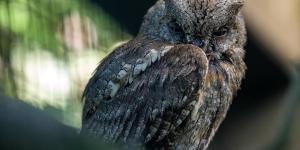Do Groundhogs Sleep at Night?

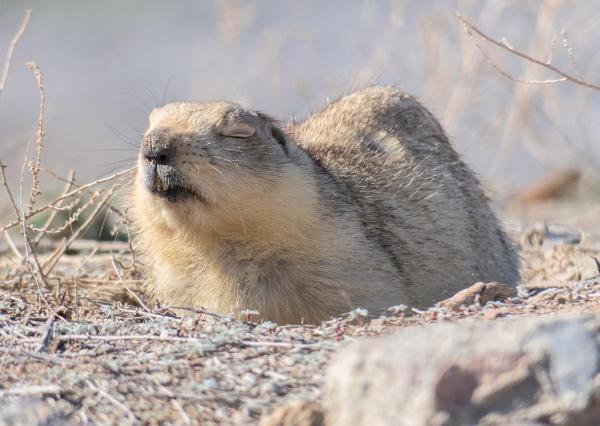
Also known as a woodchuck, the groundhog belongs to the order Rodentia and the family Sciuridae. This is the family to which squirrels belong, making them very close relatives of tree squirrels. Theirs is the genus Marmota which is divided into two subgenera, 15 species and 42 subspecies. They are generally social animals and can be aggressive towards intruders. They live mainly in underground burrows where they spend most of their time in a family group. Being subterranean for much of the time can make study of these animals difficult, especially their sleep cycles.
In this AnimalWised article, we ask do groundhogs sleep at night? By looking at the groundhog sleep cycle, we can also find out how long they sleep and whether these animals hibernate.
Do groundhogs sleep at night?
The groundhog is an animal culturally associated with sleeping, but many of us do not know much about their actual sleeping habits. How long they sleep during a day will depend on various factors, but the time of year is particularly important.
A typical aspect of the animal is the construction of complex burrow system. Burrows provide protection against predators, as well as suitable conditions to protect against harsh climates. When the temperature drops at night, the groundhogs can go deeper into the burrow to conserve heat as lower areas will be warmer than those closer to ground level.
While groundhogs have good eyesight, they do not tend to leave the burrow at night. Although some people think of them as nocturnal, groundhogs are diurnal. This means they are most active during the daylight hours. Specifically, they tend to go out scavenging for food during the early morning and the late afternoon. They are mainly herbivorous animals, but they also eat small insects and other small animals on rare occasions.
Learn more about animal activity with our article on which animals are nocturnal.
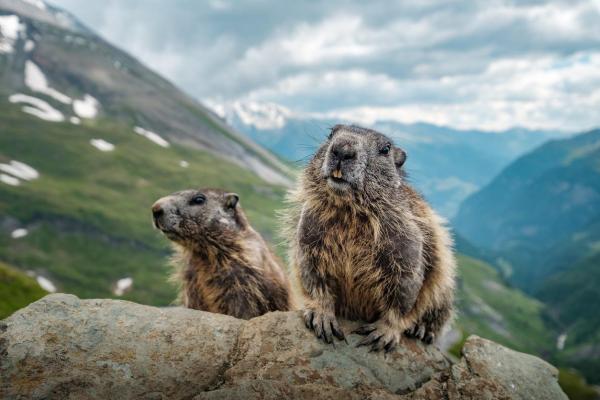
Do groundhogs hibernate?
You may know of groundhogs from the film and festival after which is is named, Groundhog Day. This event is based on the superstition that if a groundhog emerges from their burrow on a certain day and sees their shadow, they will retreat to their burrow for six more weeks of winter.
This superstition is predicated on the fact that groundhogs do hibernate. In fact, the close cousin of the groundhog known as the gray marmot (Marmota baibacina) can hibernate for up to 7 or 8 months. Generally, the groundhogs that are inactive in the winter are those which live in areas with significant temperature drops.
Although hibernation does mean they are inactive for the duration of the winter, groundhogs are not necessarily asleep for the entire time. During hibernation, groundhogs go into a state of torpor for long periods, sleeping for more than a week at a time. This is approximately 150 hours. However, it has been shown they have intervals during which they wake up from this state for around 40 hours, before entering torpor again.
The total hibernation time of groundhogs depends on the region where they live. In most of the habitats where groundhogs live, the cold will extend from October until spring, but some may only hibernate for as little as three months.
The complex burrow system of the groundhog is beneficial for hibernation. They are an animal which enters true hibernation, meaning they spend the whole winter hibernating. Being underground also helps to protect them from the cold.
How do groundhogs hibernate?
The groundhog's hibernation process is different to their normal sleep cycle. It is an involved process which needs preparation for it to be successful.
Various species of groundhog live in regions with extreme winters. They are subjected to low temperatures, which mainly influence the availability of food. Given these environmental conditions, the vegetation decreases considerably and the groundhogs run out of available food. For this reason, they have developed this strategy of sleeping for long periods with the metabolism functioning at a minimum in order to survive.
The two main stages of the hibernation cycle are:
- Preparation phase: the groundhog must prepare for their extended torpor. During the months leading up to winter, they will gorge on food as much as possible. This will allow the animal to store nutrients in their body which will be slowly metabolized during hibernation. During the months before hibernation, these animals carry out activities such as storing fat reserves, reproduction and social interaction. When they enter hibernation they will be at their maximum weight for the year.
- Hibernation phase: with short periods of activation. When it enters the hibernation process, the groundhog decreases their metabolism by up to 90%. Their heartbeat will slow to 4-10 bpm and their body temperature can be as low as 35 ºF. Although it is not exactly clear why, it is estimated they have some short periods of activity to guarantee functioning at the cellular level and carry out the excretion process. When they emerge they will have lost around half their body weight.
When the winter is extended for a few more weeks, these animals tend to continue in torpor. Due to a lower body weight, some young individuals consume so much of their their body reserves, it can lead to the death of the animal.
Many animals decrease their activity and enter a dormant sleep for long periods. Not all perform hibernation. Learn more about brumation in animals and the differences between this process and hibernation.
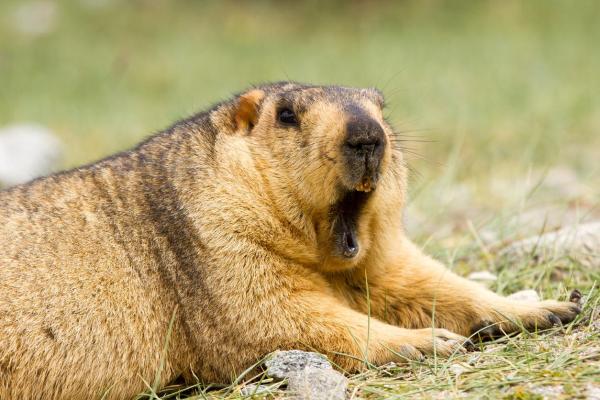
How do groundhogs sleep?
As we have explained, groundhogs prepare for their hibernation periods. It is a quite complex state that requires certain conditions. Once they are ready to go into hibernation, they then prepare the burrow, which will generally be deeper than where they are located at other times of the year.
Woodchucks sleep in groups. The family group enters the burrow, then they form balls of earth, dung and even rocks to form a plug that closes the entrance to the burrow. This will help keep the heat inside the burrow space. Sleeping in a group also facilitates a higher temperature due to the union of the bodies in that limited space.
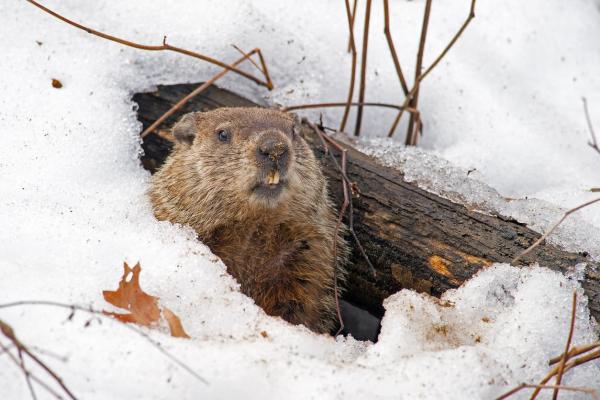
How long do groundhogs sleep normally?
Groundhogs are not only nocturnal, but as a hibernating species they will sleep for weeks on end. However, when they are not hibernating, they still aren't the most active of animals. Even during the summer months, they can sleep between 16 to 20 hours per day. While this is nothing compared to the 150 hours sleep stretches during hibernation, it is still a significant of sleeping time.
If you want to read similar articles to Do Groundhogs Sleep at Night?, we recommend you visit our Facts about the animal kingdom category.
- Ferrandiz, M. (2017). Alpine marmots. Retrieved from: https://www.investigacionyciencia.es/revistas/investigacion-y-ciencia/la-observacin-de-ondas-gravitacionales-695/marmotas-alpinas-14936
- Letzter, R. (2019). Here's What Groundhogs Will Do If Winter Goes Long . Retrieved from: https://www.livescience.com/64672-groundhog-day-hibernation.html
- Myers, P. R., et al. (2022). The Animal Diversity Web (online). Retrieved from: https://animaldiversity.org.
- STIs. (2021). Marmot. Retrieved from: https://www.itis.gov/servlet/SingleRpt/SingleRpt?search_topic=TSN&search_value=180136#null




